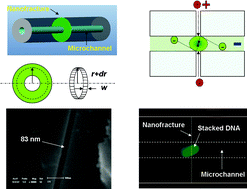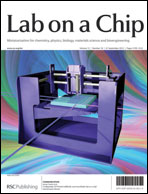Due to Donnan exclusion, charged molecules are prohibited from passing through a channel of electrical double layer scale (nanometers), even though the molecules are smaller than the lowest dimension of the channel. To employ this effect for on-chip pre-concentration, an ion channel of nanometer scale has to be introduced. Here we introduced a simple method of generating a fracture (11–250 nm) directly on the commercially available open tubular fused silica capillary, and a chip comprised of the capillary with the nanofracture was prepared. A ring-disk model of the fracture was derived with which the fracture width can be easily characterized online without any damage to the chip, and the result was validated by a scanning electron microscope (SEM). The fractures can be used directly as a nanofluidic interface exhibiting an obvious ion concentration polarization effect with high current flux. On-chip electrokinetic stacking of SYBR Green I labeled λDNA inside the capillary was successfully demonstrated, and a concentration factor close to the amplification rate of the polymerase chain reaction (PCR) was achieved within 7 min. The chip is inexpensive and easy to prepare in common chemistry and biochemistry laboratories without limitations in expensive microfabrication facilities and sophisticated expertise. More applications of this interface could be found for enhancing the detectability of capillary based microfluidic analytical systems for the analysis of low concentrated charged species.

You have access to this article
 Please wait while we load your content...
Something went wrong. Try again?
Please wait while we load your content...
Something went wrong. Try again?


 Please wait while we load your content...
Please wait while we load your content...